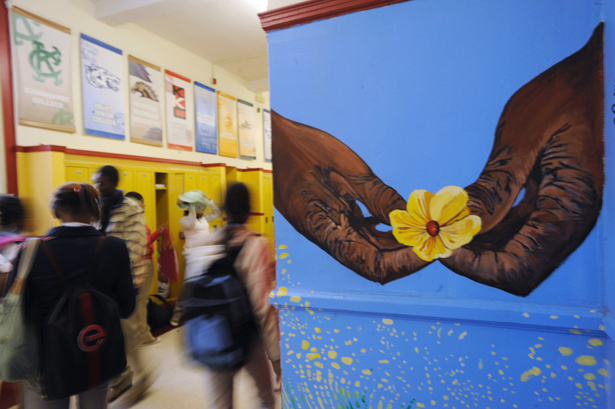
(AP Photo/Paul Beaty)
This week students at New York’s Stuyvesant High School (my alma mater) protested a discriminatory dress code by participating in “Slutty Wednesday”—a day in which students deliberately violated the code that bars them, among other restrictions, from wearing anything that bares their shoulders. (The horror!)
Senior Madeline Rivera told the New York Times that the way in which the dress code is enforced singled those out those with certain “body shapes” or those who were “more curvy.” In fact, according to reports from students over the past few months, the code almost exclusively targets women in language and practice—a possible violation of their Title IX rights.
Another senior, Lucinda Ventimiglia, told the student newspaper, the Spectator, “I’ve been told that even though my skirts were technically acceptable, they were still too short for me to wear, and once it was suggested that I should follow a separate dress code, wherein my skirts should end at least four inches past my fingertips, and preferably at my knees.”
Ventimiglia also recalled being stopped by a school official who told her that her dress was too short that that she could “show off her curves” when she wasn’t in school. “She then went on to say that the dress code was only instituted for my protection, because there are a lot of bad men outside school, and if I was raped nobody would be able to take that away from me. Then, she said, ‘and you want a husband, don’t you?’ ” (For the record, what a woman wears is in no way connected to sexual assault.)
Tiffant Phan, a junior, says that Assistant Principal Randi Damesek stopped her for what she felt was an entirely appropriate outfit.
“Ms. Damesek took one look at me, sighed, and asked me what I was thinking when I went out of the house that morning. All I wore was a long-sleeved button-down, which was secured by a navy skirt and accompanied by floral cutout tights; I didn’t intend for it to be inappropriate in the slightest. At the moment, I was confused because I specifically made sure that the skirt covering my patterned tights was past my fingertips. She told me that the whole outfit was bad and that I looked like I was ‘going out for a Saturday night, not going to school.’ I think we all know what she was implying.”
The young women of Stuyvesant should be able to go to class free from the fear that the faculty, administration or staff will harass them about their clothes simply because of their gender or body type. In fact, it’s their right under Title IX.
According to the Justice Department, the way in which women at Stuyvesant (and I’m betting plenty of other high schools with dress codes) are being targeted could fall under “disparate impact.”
“Under the disparate impact theory, a recipient violates agency regulations by using a neutral procedure or practice that has a disparate impact on protected individuals…[or] had a disproportionate impact on the basis of sex.”
In addition to the violation of female students’ rights, the thinking behind the code sends a dangerous message to young women – that they are responsible for the way in which society objectifies and sexualizes them.
Take this comment from Principal Stanley Teitel: “Many young ladies wear denim skirts which are very tight and are short to begin with, and when they sit down, they only rise up, because there’s nowhere else to go…. The bottom line is, some things are a distraction, and we don’t need to distract students from what is supposed to be going on here, which is learning.”
It’s not the responsibility of female students to mitigate the male gaze. You find female bodies “distracting”? That’s your problem, not women’s. Society teaches that women exist to be looked at, objectified and sexualized—it’s up to others to make sure that they don’t contribute to that injustice.
The students at Stuyvesant are some of the brightest out there—they want to learn and to engage with each other and the world around them. Whether or not they wear tank tops or shorts while they do so is irrelevant.
I’m glad the students are taking action—though I hope they don’t just limit it to one day. If my daughter were a student at Stuyvesant, I’d encourage her to break the dress code until the administration changed it. Because the real “distraction” here isn’t skirts—it’s is the shaming and shameful way this high school is treating women.


